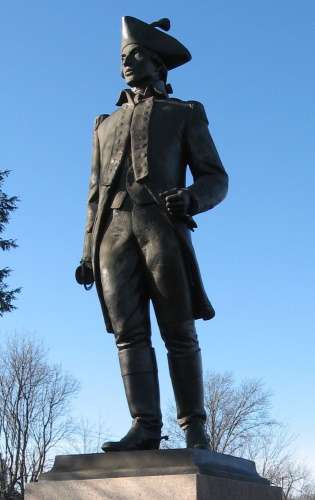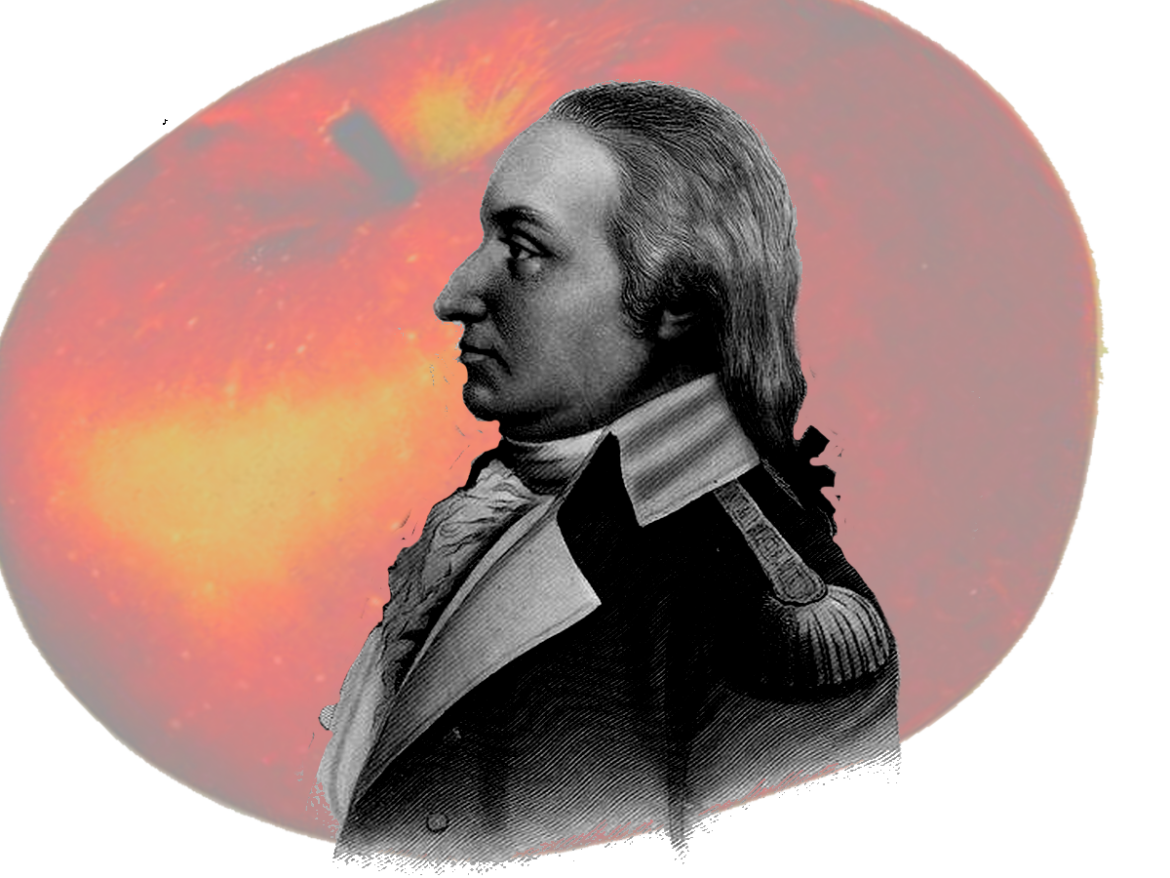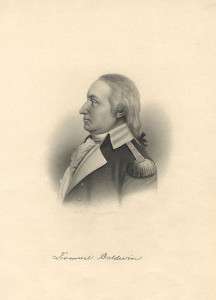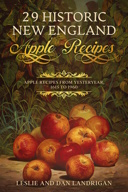So revered is the Baldwin apple that Massachusetts has not one but two monuments to the bright red winter fruit.
For many years, the Baldwin apple was the most popular fruit in New England and New York. A small hard apple remarkably free of blight and blemishes, people prized it for making hard cider and pie. Commercial growers loved it because it produced huge crops every other year and shipped easily.
In 1885, an article in the New England Farmer praised the apple: “What the Concord is among grapes, what the Bartlett has been among pears, the Baldwin is among apples.”
Wilmington Origins
The Baldwin apple originated as a wild seedling on the farm of John Ball in Wilmington, Mass., around 1740. William Butters bought the farm and transplanted the tree near his house. He called the apple ‘Woodpecker’ because the tree attracted so many of the birds. Others called it the Butters apple.
In the late 18th century, Deacon Samuel Thompson stumbled across that apple tree while surveying for the Middlesex Canal. He told the canal’s engineer, Loammi Baldwin, about the fine red apple. Baldwin quickly recognized its appeal.
The Baldwin Apple
Loammi Baldwin accomplished many things in his lifetime, but he is best known for promoting the eponymous apple.
Born Jan. 10, 1744, he was a Revolutionary War veteran who crossed the Delaware with George Washington. Baldwin commanded the Woburn Regiment during the Battle of Concord and Lexington. He conducted experiments with electricity and served in the Massachusetts General Assembly and as high sheriff of Middlesex County.
Baldwin’s most significant achievement was the construction of the Middlesex Canal, a pioneering waterway that connected the Merrimack River to Boston Harbor. He earned the moniker ‘Father of Civil Engineering’ because of his innovations – and perhaps because his five sons became well-known civil engineers.

Statue of Loammi Baldwin in Woburn, Mass.
While building the canal, he visited the Butters farm and cut scions from the Woodpecker apple tree. He then planted a row of trees near his house in Woburn and gave away scions to his friends. Some say the apple was named for him after his death. But according to Woburn historian Rev. Samuel Sewall, the proposal to name the apple after Baldwin happened at a party he held.
Fittingly, Loammi Baldwin was a second cousin to Johnny Appleseed.
Apple historian John Bunker writes that Baldwin apple trees are especially vulnerable to winter injury. The cold weakens them from harvest time until recovery during the next off season.
The severe winter of 1933-34 wiped out millions of apple trees in New Hampshire, Vermont and Massachusetts. In Maine, two-thirds of the apple trees died. Throughout New England, the cold hit the Baldwin apple the hardest.
Then in the spring of 1934, the State of Maine organized a tree pool for apple growers, offering two varieties: Red Delicious and MacIntosh.
Monumentally Popular
In 1895, the Rumford Historical Association erected a monument to the apple in Wilmington, near the site of the original tree.
The monument’s inscription notes the tree fell in the gale of 1815. And it says the apple ‘first known as the Butters, Woodpecker or Pecker apple’ was named after Col. Loammi Baldwin of Woburn.
Another memorial to the Baldwin apple can be found on a plaque on the base of a statue of Loammi Baldwin in Woburn. It reads, “Disseminator of the apple in honor of him called the Baldwin which proceeded from a tree originally growing wild about two miles north of this monument.”
Click here to read about a historic apple orchard in your state.
Read more surprising apple history along with historic apple recipes in the New England Historical Society’s e-book, 29 Historic New England Apple Recipes. Available now for only $2.99 from Amazon. (Click here.)
With thanks to John Bunker, Not Far From the Tree–a Brief History of the Apples and the Orchards of Palermo Maine 1804-2004. This story was updated in 2024.
Image of Loammi Baldwin statue By Shorelander (self) – Own work, CC BY 2.5, https://commons.wikimedia.org/w/index.php?curid=1578711.





18 comments
One of my favorites!
Mine, too, Margaret!
Love to make Apple Crisp with them!
In the past, there have been other places claiming to be the home of the Baldwin Apple, but after considerable research on this, I firmly believe that the original tree was found in Wilmington. However, it was not on land once owned by John Ball. Will Butter was the first settler (c. 1665) in the area where the tree grew. It was his grandson who was credited with finding the tree. Ball actually lived in Tewksbury, and did grow apples on his farm there. He died on June 1, 1797 in his 78th year (Wilm. v.s.) at the home of his son-in-law, Dr. Jabez Brown, who lived on Hardscrabble, now High Street in North Wilmington. Given that he was born about 1820, it is not possible that he sold land to William Butters.
An historical account published in 1932 states that Colonel Baldwin developed the Baldwin apple from a tree at “The Shrubbery,” Aaron Burr’s estate in Pelham, New York. See Citizen-Sentinel, Ossining, New York, February 6, 1932, p. 4 “Westchester Yesterdays.”
[…] Federal-style mansion that was once the home of Loammi Baldwin, a Revolutionary War veteran. The Baldwin apple was named after him, but even that wasn’t his claim to fame. He built the Middlesex Canal, once a […]
[…] behind to life, planting a tiny timber of heirloom apples and pears grown by a Dickinsons — Baldwins, Westfield Seek-No-Furthers, Winter Nelis — on a balmy dilemma of a skill circuitously Triangle […]
[…] back to life, planting a small grove of heirloom apples and pears grown by the Dickinsons — Baldwins , Westfield Seek-No-Furthers , Winter Nelis — on a sunny corner of the property near Triangle […]
[…] back to life, planting a small grove of heirloom apples and pears grown by the Dickinsons — Baldwins, Westfield Seek-No-Furthers, Winter Nelis — on a sunny corner of the property near Triangle […]
[…] back to life, planting a small grove of heirloom apples and pears grown by the Dickinsons — Baldwins, Westfield Seek-No-Furthers, Winter Nelis — on a sunny corner of the property near Triangle […]
Don’t know who actually developed the Baldwin, but my favorite is the Macintosh. I was a distant relation to Johnny Appleseed and I know he disbursed the apple tree far and wide. I was also related to the Baldwin family but not as directly. It makes me proud that my family were planters in the Merrimack Valley, but they were also tanners and probablycontributed greatly to polluting the water in Woburn, and surrounding towns.
Dianne, the very early tanners didn’t use harmful chemicals in the tanning process. They used natural methods that were not hazardous. Unfortunately, in the 1800’s and on, poisonous chemicals made their way into the profession and disposing of them usually meant dumping them into wetlands or a pit in the ground. Few had any idea they would find their way into nearby wells… and those who might have known were too blinded by money to care. Are you any relation to Woburn’s early Bartholomew Richardson?
[…] year, the regional market was saturated and the buyers were offering a dollar a barrel for the best Baldwins. Many comments made within the Bridgton NEWS indicate that this was just over break-even. The crop […]
[…] Burbank’s own P.T. Barnum style helped fuel his image. He once showed off a single apple tree that, through countless grafts, grew 73 varieties of […]
[…] The Baldwin Apple. The Baldwin apple made its debut on the farm of John Ball of Wilmington, Massachusets in 1740. It was a random hybrid and for about 40 years, it was only grown in and around Wilmington. But it got its name from Loammi Baldwin, a farmer and hero of the American Revolution who promoted the variety aggressively. Firm, bright red and a reliable and abundant crop, the Baldwin was for many years the most popular apple in New England and New York. […]
[…] truth, his apples had one purpose, and it wasn’t to make pies and crumbles. Farmers could only make hard cider from […]
[…] corporation chose Loammi Baldwin, a self-educated Revolutionary War veteran, as chief […]
[…] apple pie. In the fall, they had strung up apple slices and hung them outdoors to dry. Once dried, the apples hung in a home’s rafters for the winter until needed. Then, in the spring, the family cook would […]
Comments are closed.